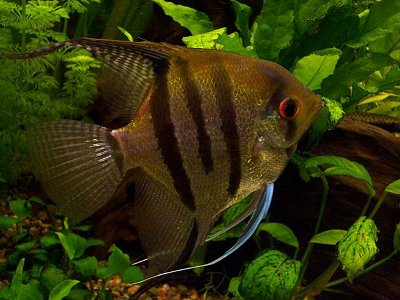Angelfish
Category: Angelfish

Facts about Angelfish, "Scientific name for Angelfish is Pterophyllum scalare". Angelfish live in freshwater and are Amazonian natives, the Essequibo River and Orinoco river basins in tropical South America. Angelfish come from a family known as Cichlidae and are called Pterophyllum. There are three species found in the Angelfish family of, the P. Leopoliand, P. Scalare and P. Altum. Out of the three the P. Scalare is the most common and popular that are in house aquariums. Angelfish breeders have also developed different colored varieties and special fin traits. Natural Angelfish have vertical colored stripes they use as camouflage in the wild. The Angelfish have round thin bodies and elongated triangular anal and dorsal fins. They can grow up to six inches () in height.
You want to go with at least a 50 gallon () minimum tank size, Angelfish are very territorial if you going to keep 2 to 4 Angelfish. The temperature in you tank ideally should be kept between 77 F to 80 F (25 to 27deg Celsius). The preferred pH between 6.3 to 7.0. but can also live in other ranges of pH waters. Angelfish have a aggressive behavior and trouble coexisting with other fish, Angelfish should be only kept with its own species. They will cause havoc when kept with different types of fish, attacking other types of smaller fish and consuming young fish fry.
In about a year and a half, Angelfish will reach their full adult size. Angelfish, there environment is a big factor that contributes to the growth of the Angelfish, such as the quality of food. However, when it comes to water cleanliness, it is very important to maintain perfect water condition, Anglefish are very pron to catching white spot disease or ick. Live plants for your tank are recommended, the ones with big leaves for easy maintenance such as sword plants. Make sure before you add anything into your angelfish tank you make sure, all plants and tank decorations have been properly rinsed off and cleaned or you might introducing pesky snails to your tank. Plants will help to maintain a better quality of water.
Breeding Angelfish can be quite a challenge hoping you have an active breeding pair or they will not spawn. Sometimes if you only have a few Angelfish, you will not be shore if you have males and females. Once you find a successful pair of breeders, it would be good a idea to separate them out from the rest by putting into other separate fish tank for successful breeding. The breeding pair will become aggressive toward the other Angelfish and attack them if they are left together, especially during spawning. Sometimes you can stimulate spawning, by doing a partial water change in order to change the water temperature range to become 2 to 3 degrees higher than normal.
Angelfish Diet
The fact is that a Angelfish are omnivorous, (definition-they eat both other animals and plants). The Angelfish eats aquatic insect larvae, worms and aquatic crustaceans. Us a tropical flake or pellet fish food. Angelfish will enjoy frozen or fresh bloodworms, daphnia or brine shrimp.
In the wild Angelfish like hiding in areas near caves where there is soft and stony corals. That's were the Angelfish feed on tunicates, sponges benthic algae and weeds.
Angelfish Aquarium care
Test the water when preparing your tank for your Angelfish: You will need to purchase a liquid tester so that you can test for Nitrates and Ammonia. The strip-style test kits are unreliable and a waste of money. You should use a dechlorinating product to remove the harmful chlorine from the water. Test for nitrite, ammonia, and proper PH. The ammonia should always be 0, the nitrite should be 0, and the nitrate should preferably be below 20 ppm. If it's at or above 40 parts per million (ppm), you have too many fish or are not changing the water often enough. Cycling your tank is important, Follow the steps to cycle your tank. This establishes healthy bacterial and chemical levels.
When buying your Angelfish see which one looks like the healthier Angelfish in the tank. Be wary of tanks with dead fish in them, as this can be a sign of illness or improper care. Clamped fins are a sign of illness. In addition, healthy Angelfish will have no white spots, make sure they swim with their fins held upright, and have a nice rich color or colors. Make sure the Angelfish swim all over the tank and look healthy.
When adding the Angelfish to the aquarium, it is important to introduce the fish to the tank environment slowly. As soon as you get home, float the entire, closed pet store bag (with the Angelfish inside!) in the tank on top of the water for about a half hour. This will allow the water in the plastic bag and the Angelfish to equalize out to the same temperature as in your tank, so your fish does not get shocked by the different temperature. Next, add a small amount of water from your tank to the bag, and wait about 15 minutes. Do this at least one more time. Us a net to catch your Angelfish and then while the fish is in the net, dispose of all the water down a drain or outside. Then transfer the Angelfish carefully into the your tank. This process not only reduces stress for you Angelfish, it also prevents the dirty pet store water from contaminating your tank with disease.
Remove 30% of the water from you Angelfish tank each month with new water, or a 15% water change every 2 weeks is ideal for keeping nitrates lower. With corals in the Angelfish tank, then 20% water change every month, or 10% change every 2 weeks.

 Back To Category Angelfish
Back To Category Angelfish